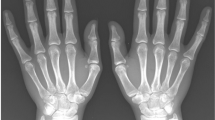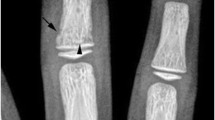Abstract
Background
Phalangeal microgeodic disease is a rare and benign self-limited condition involving the phalanges, often in the setting of cold exposure, with characteristic MR imaging abnormalities. Radiographic case descriptions are predominantly from Asia and Europe, with only seven cases using MR to characterize phalangeal microgeodic disease.
Objective
In this study we describe the MR imaging appearance of unusual and striking phalangeal signal abnormality compatible with phalangeal microgeodic disease at our institution in North America.
Materials and methods
We retrospectively reviewed cases presenting at our institution with unusual or unexplained phalangeal signal abnormalities between 2001 and 2014. We reviewed the MR imaging appearances in conjunction with radiographs and any other available imaging investigations.
Results
Of 189 examinations reviewed during the study period, 8 imaging studies in 6 patients met the study inclusion criteria. Signal abnormality was present in 57 of 112 phalanges (51%), frequently involving the distal phalanges (70%, 28 of 40), followed by the middle phalanges (56%, 18 of 32) and the proximal phalanges (28%, 11 of 40). The pattern of involvement was most commonly diaphysis (38%), followed by metaphysis (32%) and epiphysis (30%). The extent of MR signal abnormality was greater than that suspected based on clinical presentation or on radiographs.
Conclusion
The presence of unexplained diffuse characteristic marrow involvement of multiple painful phalanges on MR images, often in the setting of cold exposure, should raise the possibility of phalangeal microgeodic disease. Consideration of this diagnosis based on MR findings would lead to a more conservative management and avoid unnecessary invasive diagnostic procedures.



Similar content being viewed by others
References
Maroteaux P (1970) Cinq observations d’une affection microgeodique des palanges du nourisson d’etiologie inconnue [Five cases of microgeodic disease of phalanges of unknown etiology in infants]. Ann Radiol 13:229–236
Inoue G, Miura T (1991) Microgeodic disease affecting the hands and feet of children. J Pediatr Orthop 11:59–63
Van Ackere T, Eykens A, Wouters C et al (2013) The phalangeal microgeodic syndrome in childhood: awareness leads to diagnosis. Eur J Pediatr 172:763–767
Kaibara N, Masuda S, Katsuki I et al (1981) Phalangeal microgeodic syndrome in childhood: report of seven cases and review of the literature. Eur J Pediatr 136:41–46
Fujita A, Sugimoto H, Kikkawa I et al (1999) Phalangeal microgeodic syndrome: findings on MR imaging. AJR Am J Roentgenol 173:711–712
Lee RK, Griffith JF, Read JW et al (2013) Phalangeal microgeodic disease: report of two cases and review of imaging. Skelet Radiol 42:451–455
Onishi Y, Hitora T, Kawaguchi Y et al (2010) Magnetic resonance imaging findings of microgeodic disease of the toe: a case report. Foot Ankle Int 31:251–253
Nishino A, Kawashiri SY, Nakashima Y et al (2013) Two rare cases of adult-onset phalangeal microgeodic syndrome with magnetic resonance imaging-proven bone edema transiently occurring in winter. Joint Bone Spine 80:523–524
Yamamoto T, Kurosaka M, Mizuno K et al (2001) Phalangeal microgeodic syndrome: MR appearance. Skelet Radiol 30:170–172
Aihara T (2001) Phalangeal microgeodic syndrome. Semin Musculoskelet Radiol 5:99–101
Crouch C, Smith WL (1990) Long term sequelae of frostbite. Pediatr Radiol 20:365–366
Prindaville B, Antaya RJ (2013) Chilblains and microgeodic disease diagnosed concurrently in a child’s toe. Pediatr Dermatol 30:269–270
Smitaman E, Pereira BPG, Huang BK et al (2016) Abnormal bone marrow signal intensity in the phalanges of the foot as a manifestation of Raynaud phenomenon: a report of six patients. AJR Am J Roentgenol 30:1–5
Kashiwa K, Yagi M, Futani H et al (2008) Microgeodic disease affecting the toes in athletes: a report of 2 cases. Am J Sports Med 36:1190–1192
Howard CB, Alkrinawi S, Gadalia A et al (1993) Bone infection resembling phalangeal microgeodic syndrome in children. A case report. J Hand Surg (Br) 18:491–493
Yamamoto T, Marui T, Akisue T et al (2004) Phalangeal microgeodic syndrome resulting in rapid digital shortening. Clin Orthop Relat Res 424:191–193
Falip C, Alison M, Boutry N et al (2013) Chronic recurrent multifocal osteomyelitis (CRMO): a longitudinal case series review. Pediatr Radiol 43:355–375
Subasi M, Bukte Y, Kapukaya A et al (2004) Tuberculosis of the metacarpals and phalanges of the hand. Ann Plast Surg 53:469–472
Wilcox A, Bharadwaj P, Sharma OP (2000) Bone sarcoidosis. Curr Opin Rheumatol 12:321–330
Acknowledgments
We would like to thank Gail Pyne-Geithman, PhD, for her editorial assistance in preparation of this manuscript.
Author information
Authors and Affiliations
Corresponding author
Ethics declarations
Conflicts of interest
None
Rights and permissions
About this article
Cite this article
Radhakrishnan, R., Emery, K.H. & Merrow, A.C. Diffuse phalangeal signal abnormality on magnetic resonance imaging: phalangeal microgeodic disease. Pediatr Radiol 47, 313–320 (2017). https://doi.org/10.1007/s00247-016-3763-z
Received:
Revised:
Accepted:
Published:
Issue Date:
DOI: https://doi.org/10.1007/s00247-016-3763-z




